
|
Mount McKinley 2013 - Meteorology |

|
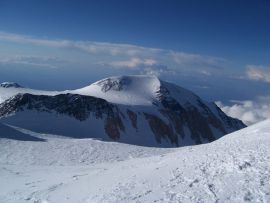
|
|
19,470 foot North Peak from the standard summit route. |
Here I use treeline elevation as a surrogate for the combined effects of altitude and latitude on climate. Thus at Advance Base Camp, 11,600 feet above treeline, the climate is in theory similar to what would be encountered in southern California at 23,000 feet!
2Stormy weather arrives from the nearby Gulf of Alaska to the southwest. Winds batter the higher elevations unabated by local terrain - the "upper mountain" above Advance Base Camp. Travel there is limited to periods of relative calm, and its absence opens the way for expedition failure when fuel and food eventually run dry.
In this upper realm the diurnal temperature variation is remarkably small because there is little or no landmass to moderate the airflow. Summit temperatures thus differ very little between day and night, and similarly at High Camp. Lower down, such as at Kahiltna Base Camp, daily temperature swings are large.
Expeditions generally travel during storms on the "lower mountain" below Advance Base Camp. Here the temperatures are more moderate, such that the wind chill of a 25 miles per hour breeze is not a showstopper calling for immediate shelter. Such a wind higher up would generally result in a "rest day" or "acclimatization day" - positive-outlook euphemisms for "the weather has us holed-up in camp".
1 An accurate comparison is not feasible as there are no trees in Antarctica.
One must guess the hypothetical treeline's negative elevation.

|
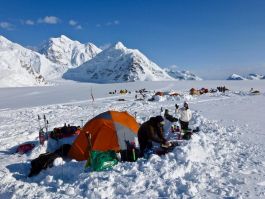
|
|
Mount Francis (center) and Mount Hunter (left horizon) from Ski Hill camp. |
Conditions are generally even worse at High Camp owing to significantly larger exposure to the elements and the continual hardship of attempting to function at over 17,000 feet elevation - near the limit of how high humans can adapt to in the long-term.
April is still too cold.
The climbing season begins in early May when conditions remain cold enough on the Kahiltna Glacier to travel during normal hours. The fixed lines are climbed in daylight. In contrast June sees the lower route begin to deteriorate. One then is advised to travel in the morning's early hours well before direct sunlight hits the glacier.
It's all for safety this intentional jet lag from shifting the wake-sleep cycle several hours.
when people are inattentive and prone to making serious, often fatal mistakes.
(On the other hand Jean François' internal clock is perfectly accomodated.)
I claim that the lowered probability of a crevasse fall might be countered in equal measure by simple errors, such as failing to double-back one's climbing harness loop, simply because one is tired and forgetful.
'Nuf said.
Choose your poison!

|
Mind you, it can be unusually balmy in May and frigid in late June. The long-term trend is for warmer conditions, with the abnormal outcomes of our expedition a case in point.
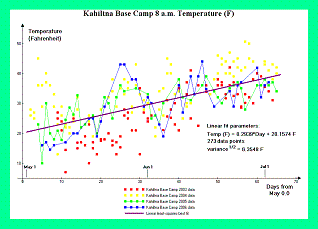
|
|
8 a.m. temperatures at Kahiltna Base Camp for 2003-2006. Mouse-click to clearly view data. |
KAHILTNA BASE CAMP to 7,800 FEET. Overnight low 25° F; afternoon high 40° F. Bring a tee-shirt and a sunhat for daytime use at camp - it can feel like an oven with the snow's reflecting power. Rain is possible at this elevation, such that a rain-impermeable shell is recommended. No need to keep water bottles in bed.
ABOVE SKI HILL to WINDY CORNER. Overnight low 15° F; afternoon high 30° F. It can still be a challenge staying cool during the daytime with direct sun. However rain is seldom enountered. Consider traveling at night with three rather than a pair of layers. Place water in between sleeping bags - and urine bottle as well.
ADVANCE BASE CAMP (14,300 FEET). Overnight low 5° F; afternoon high 15° F. Direct sunlight from 9:25 a.m. through 8:55 p.m. on the summer solstice (June 21).
This camp is well sheltered, an ideal location for acclimatizing. It can be remarkably balmy inside your tent mid-day, the very high altitude sun being exceptionally strong in its warming capacity. However at night it will be below freezing inside the tent - so take water bottles to bed with you inside the sleeping bag. A frozen water bottle is good for nothing and will annoy anybody who must deal with it. Urine bottles should be treated similarly.
HIGH CAMP (17,200 FEET). Overnight low -5° F; afternoon high 5° F. The cold is powerful enough that even direct sunlight fails to provide a full measure of relief. Wear your expedition parka when not moving. Hopefully you need not endure these conditions for much longer!!
An "ideal" SUMMIT DAY features not a breath of wind and temperatures around zero Fahrenheit. I have read accounts of climbers pleasantly surprised that they did not need their expedition parka the entire day. All other articles of clothing are worn - including "puffy pants" and summit mittens. Winds exceeding perhaps 20 miles per hour generally mean remaining in camp.
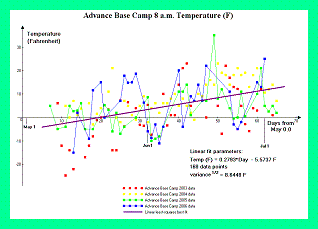
|
|
8 a.m. temperatures at Advance Base Camp for 2003-2006. Mouse-click to clearly view data. |
Note how the daily temperature variation declines with each successively higher venue. With a substantial wind the sensation of cold is markedly enhanced. I cannot suggest an upper limit to how windy it must be before a summit attempt is postponed - it depends on your level of commitment; willingness to sacrifice fingers; and any innate suicidal tendencies. Of course with a guided expedition you lose all decisionmaking power in this matter.

|
Consider wearing liner gloves underneath so that your hands are never directly exposed to the cold and wind. Unfortunately they can easily get wet. Hence I have three pairs, such that a damp set can be drying while another is in-use.
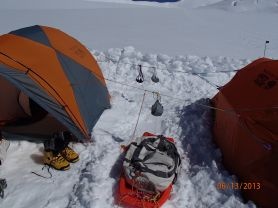
|
|
Tents can be lashed together for additional sturdiness. Adam's inner boots face the sun. |
Liner gloves are not an option when I emplace crampons which are generally damp from caked-on snow and ice. It's an issue because at least on this climb one is prohibited from bringing crampons near the tent - forcing me to use a sunken latrine to at least get out of the wind for this procedure. Blowing hot air on my poor fingers for several seconds sets things straight - and back they go into my heavy gloves.
Additional recommendations are in the
Mountain Trip
Expedition Equipment List (Adobe PDF document).
We cook and eat inside a kitchen tent while above Ski Hill - the pyramidal megamid or just "mid". This is important as I would not have been able to properly eat, let alone enjoy my meals outside when forced to wear mittens: I constantly add spices located in ziplock bags; salt the food (often with potassium chloride to avoid a deficiency once encountered); and otherwise perform operations requiring fine hand movements.
Furthermore, hot food cools too quickly if eaten outdoors. Owing to their shape, breakfast pancakes are a special problem in this regard - as is pizza or anything else of a flattened cross section since they lose heat far too rapidly. Beverages stay hot a long time within an insulated drinking mug.

|
The same weather system creates record high temperatures elsewhere -
I fear that future expeditions will be hobbled by some new National Park Service regulation prohibiting daytime travel past Windy Corner and along the fixed lines through some knee-jerk reaction to our once-in-a-decade weather event.
The NPS is indeed capable of such an edict because they've done it before in response to once-only events -
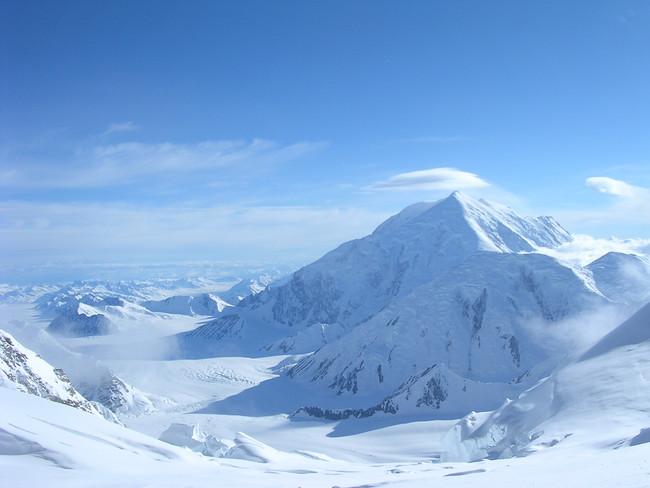
|
| Mount Foraker from 13,000 foot Windy Corner. |
| previous page - Mental, Emotional and Personal Issues | next page - Food and Drink |